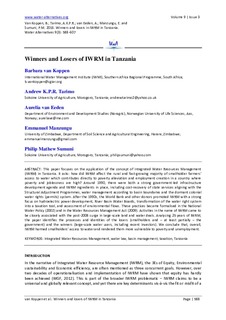| dc.description.abstract | This paper focuses on the application of the concept of Integrated Water Resources Management (IWRM) in Tanzania. It asks: how did IWRM affect the rural and fast-growing majority of smallholder farmers' access to water which contributes directly to poverty alleviation and employment creation in a country where poverty and joblessness are high? Around 1990, there were both a strong government-led infrastructure development agenda and IWRM ingredients in place, including cost-recovery of state services aligning with the Structural Adjustment Programmes, water management according to basin boundaries and the dormant colonial water rights (permits) system. After the 1990s, the World Bank and other donors promoted IWRM with a strong focus on hydroelectric power development, River Basin Water Boards, transformation of the water right system into a taxation tool, and assessment of environmental flows. These practices became formalised in the National Water Policy (2002) and in the Water Resources Management Act (2009). Activities in the name of IWRM came to be closely associated with the post-2008 surge in large-scale land and water deals. Analysing 25 years of IWRM, the paper identifies the processes and identities of the losers (smallholders and - at least partially - the government) and the winners (large-scale water users, including recent investors). We conclude that, overall, IWRM harmed smallholders' access to water and rendered them more vulnerable to poverty and unemployment. | |
